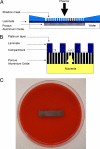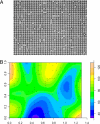The micro-Petri dish, a million-well growth chip for the culture and high-throughput screening of microorganisms
- PMID: 17989237
- PMCID: PMC2084323
- DOI: 10.1073/pnas.0701693104
The micro-Petri dish, a million-well growth chip for the culture and high-throughput screening of microorganisms
Abstract
A miniaturized, disposable microbial culture chip has been fabricated by microengineering a highly porous ceramic sheet with up to one million growth compartments. This versatile culture format, with discrete compartments as small as 7 x 7 mum, allowed the growth of segregated microbial samples at an unprecedented density. The chip has been used for four complementary applications in microbiology. (i) As a fast viable counting system that showed a dynamic range of over 10,000, a low degree of bias, and a high culturing efficiency. (ii) In high-throughput screening, with the recovery of 1 fluorescent microcolony in 10,000. (iii) In screening for an enzyme-based, nondominant phenotype by the targeted recovery of Escherichia coli transformed with the plasmid pUC18, based on expression of the lacZ reporter gene without antibiotic-resistance selection. The ease of rapid, successive changes in the environment of the organisms on the chip, needed for detection of beta-galactosidase activity, highlights an advantageous feature that was also used to screen a metagenomic library for the same activity. (iv) In high-throughput screening of >200,000 isolates from Rhine water based on metabolism of a fluorogenic organophosphate compound, resulting in the recovery of 22 microcolonies with the desired phenotype. These isolates were predicted, on the basis of rRNA sequence, to include six new species. These four applications suggest that the potential for such simple, readily manufactured chips to impact microbial culture is extensive and may facilitate the full automation and multiplexing of microbial culturing, screening, counting, and selection.
Conflict of interest statement
The authors declare no conflict of interest.
Figures




Similar articles
-
Development of a high-throughput Candida albicans biofilm chip.PLoS One. 2011 Apr 22;6(4):e19036. doi: 10.1371/journal.pone.0019036. PLoS One. 2011. PMID: 21544190 Free PMC article.
-
The Moore's Law of microbiology - towards bacterial culture miniaturization with the micro-Petri chip.Trends Biotechnol. 2008 Jul;26(7):345-7. doi: 10.1016/j.tibtech.2008.03.007. Epub 2008 Apr 29. Trends Biotechnol. 2008. PMID: 18453020
-
Growth profile and SEM analyses of Candida albicans and Escherichia coli with Hymenocallis littoralis (Jacq.) Salisb leaf extract.Trop Biomed. 2014 Dec;31(4):871-9. Trop Biomed. 2014. PMID: 25776614
-
Detection and enumeration of coliforms in drinking water: current methods and emerging approaches.J Microbiol Methods. 2002 Mar;49(1):31-54. doi: 10.1016/s0167-7012(01)00351-7. J Microbiol Methods. 2002. PMID: 11777581 Review.
-
Candida and candidaemia. Susceptibility and epidemiology.Dan Med J. 2013 Nov;60(11):B4698. Dan Med J. 2013. PMID: 24192246 Review.
Cited by
-
Emerging microfluidic technologies for microbiome research.Front Microbiol. 2022 Aug 16;13:906979. doi: 10.3389/fmicb.2022.906979. eCollection 2022. Front Microbiol. 2022. PMID: 36051769 Free PMC article. Review.
-
Bacterial swarms recruit cargo bacteria to pave the way in toxic environments.mBio. 2015 May 12;6(3):e00074-15. doi: 10.1128/mBio.00074-15. mBio. 2015. PMID: 25968641 Free PMC article.
-
Microbiota Comparison of Amur ide (Leuciscus waleckii) Intestine and Waters at Alkaline Water and Freshwater as the Living Environment.Front Microbiol. 2022 May 4;13:881132. doi: 10.3389/fmicb.2022.881132. eCollection 2022. Front Microbiol. 2022. PMID: 35602074 Free PMC article.
-
Abstracts of the 18th European Congress of Clinical Microbiology and Infectious Diseases. Barcelona, Spain. April 19-22, 2008.Clin Microbiol Infect. 2008 May;14 Suppl 7(Suppl 7):S1-815. doi: 10.1111/j.1469-0691.2008.02006.x. Clin Microbiol Infect. 2008. PMID: 18399911 Free PMC article. No abstract available.
-
Microdroplet-enabled highly parallel co-cultivation of microbial communities.PLoS One. 2011 Feb 25;6(2):e17019. doi: 10.1371/journal.pone.0017019. PLoS One. 2011. PMID: 21364881 Free PMC article.
References
-
- Carter KC. Essays of Robert Koch. Portsmouth, NH: Greenwood; 1987.
-
- Bochner B. Nat Rev Genet. 2003;4:309–314. - PubMed
-
- Tringe SG, von Mering C, Kobayashi A, Salamov AA, Chen K, Chang HW, Podar M, Short JM, Mathur EJ, Detter JC, et al. Science. 2005;308:554–557. - PubMed
-
- Kell DB, Brown M, Davey HM, Dunn WB, Spasic I, Oliver SG. Nat Rev Microbiol. 2005;3:557–565. - PubMed
Publication types
MeSH terms
Substances
LinkOut - more resources
Full Text Sources
Other Literature Sources
Research Materials

